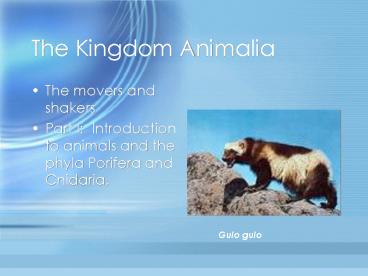The Kingdom Animalia - PowerPoint PPT Presentation
1 / 18
Title:
The Kingdom Animalia
Description:
The Kingdom Animalia The movers and shakers Part I: Introduction to animals and the phyla Porifera and Cnidaria. Gulo gulo * * * What are animals? – PowerPoint PPT presentation
Number of Views:117
Avg rating:3.0/5.0
Title: The Kingdom Animalia
1
The Kingdom Animalia
- The movers and shakers
- Part I Introduction to animals and the phyla
Porifera and Cnidaria.
Gulo gulo
2
What are animals?
- Animials are multicellular, eukaryotic
heterotrophs. - Animals are very responsive to their environment.
- All animals are capable of locomotion at some
point in their lifecycle.
Falco peregrinis
3
How do they move?
- All animals, at least during some point in their
lifecycle possess contractile fibers. - In higher animals, these contractile fibers are
called muscles. - All muscles are capable of doing is shortening
and then relaxing.
4
The phyla of the Kingdom Animalia
- There are nine phyla in the Kingdom Animalia.
- Each phyla contains animals which share many
characteristics with each other. - 8 of the phyla are considered invertebrates (this
means that a they lack a backbone. - The 9th phylum are animals with a backbone.
5
The nine phyla of Kingdom Animalia
- 1. Porifera
- 2. Cnidaria
- 3. Platyhelminthes
- 4. Nematoda
- 5. Annelida
- 6. Arthropoda
- 7. Mollusca
- 8. Echinodermata
- 9. Chordata
6
Phylum Porifera
- Members of this phylum are commonly referred to
as the sponges. - Over 5,000 species, mostly marine but some live
in fresh water. - The very simplest of animals.
- As adults they are sessile, asymetrical
filter-feeders
7
I thought all animals moved?
- Adult sponges dont move, but as larvae they do.
- The larvae can swim around.
- Eventually they attach themselves to the ocean
bottom and metamorphose into their adult form.
8
Reproduction
- Sponges are capable of sexual and asexual
reproduction. - In sexual reproduction a sperm cells swims to an
egg cell and produces a motile larvae. - Sponges can also reproduce by budding, when a
piece of a sponge breaks off and skips the larval
stage all together.
9
Cell layers
- Sponges only have two layers of cells (germ
layers). - Food is taken in by each individual cell.
- This limitation puts a size restraint on a sponge.
10
Feeding in Porifera
- Porifera feed by pumping water through its body
and filtering out nutrients. - The water is pumped by means of flagella which
line the interior of the sponge. - Oxygen is absorbed and wastes excreted during
this process.
11
Phylum Cnidaria
- The second phylum are represented by such animals
as Jellyfish and corals.
12
The Cnidarians
- Over 9,000 species, all of them are aquatic.
- Jellyfish are found in all of the worlds seas
from the equator to the poles. - Corals live in warm shallow waters only.
- Sea anenomies are marine predators which have
stings like jellyfish. - Hydra are small fresh water cnidarians.
13
Cnidarian body plan
- Cnidarians display radial symmetry.
- They have a central mouth surrounded by numerous
tentacles that extend outward from the body. - The simple digestive cavity is a two-way tract.
- Any materials which cannot be digested are passed
out of the body through the mouth.
14
Jellyfish stings
- A characteristic of jellyfish that allows them to
subdue and kill their prey are called
nematocysts. - Each nematocyst contains a small vesicle filled
with toxins, an inner filament and an external
sensory hair. - When the hair is touched, it mechanically
triggers the cell explosion, a harpoon-like
structure which attaches to organisms that
trigger it, and injects a dose of poison in the
flesh of the aggressor or prey
15
Dangerous Jellies
- While most jellyfish stings are painful, only a
few are considered life-threatening. - Box Jellies and Irukanji, both found in
Austrailian waters are the most dangerous. - http//video.google.com/videosearch?clientsafari
rlsen-usqjellyfishoeUTF-8um1ieUTF-8saNh
lentabwv
16
Jellyfish types
- There are several different families of
Jellyfish. - Some, like the portugese man-o-war do not swim,
but float by means of a bladder that acts like a
sail. - Other jellyfish actively swim through the oceans.
17
Corals
- Corals reproduce sexually as both sperm and eggs
are released into the surrounding water. - Larval corals are free swimming organisms.
- They attach themselves to rock on the ocean
bottom and metamorphose into adults.
18
Marine ecosystems
- Corals play a very important role in maintaining
biodiversity. - Coral reefs support some of the most diverse
communities of plants and animals on earth. - Rising water temperatures have a negative impact
on coral reefs.































